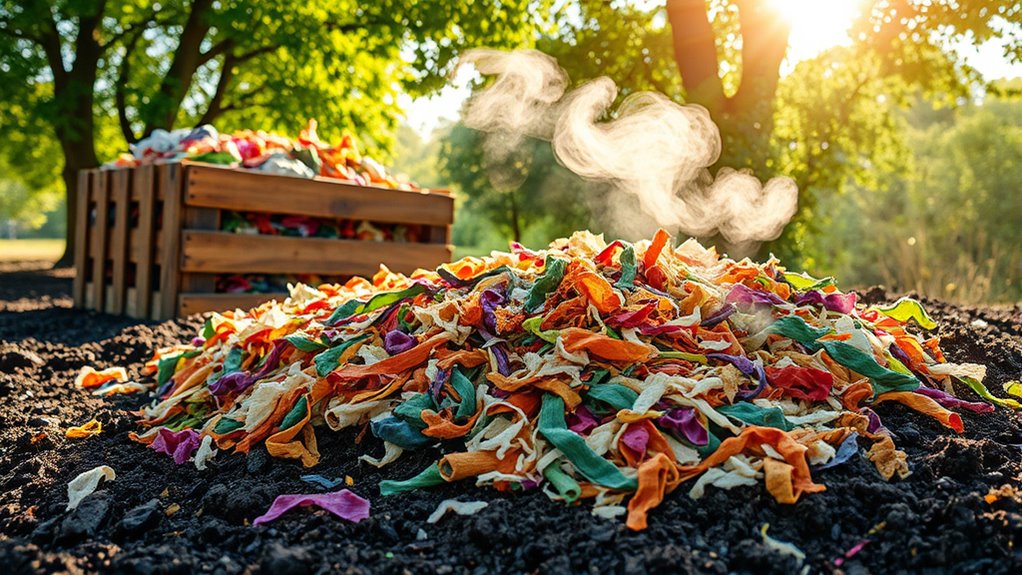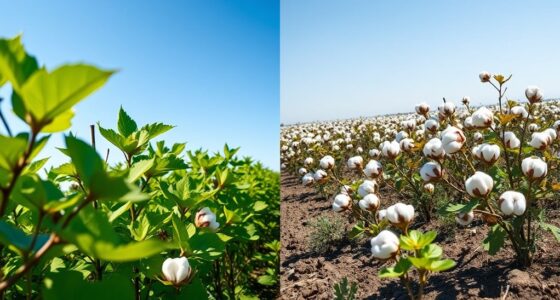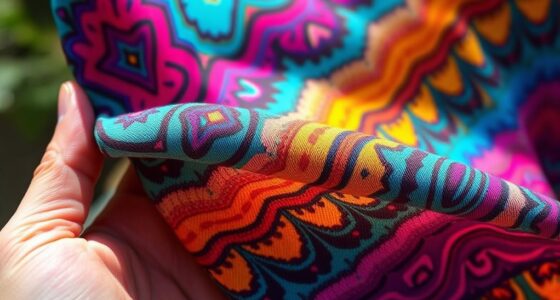To compost old clothes, start by selecting biodegradable natural fibers like cotton, linen, hemp, or wool, and cut them into small pieces to speed decay. Remove non-biodegradable parts such as zippers and synthetic trims. Mix fabric scraps into your compost pile with kitchen and yard waste, layering appropriately and maintaining moisture. Turning the pile helps microbes break down fibers faster, transforming your clothes into rich soil. Continue exploring the process to learn how to optimize composting and make your soil even healthier.
Key Takeaways
- Use only biodegradable natural fabrics like cotton, linen, hemp, and wool for safe composting.
- Cut fabric scraps into small pieces and remove non-biodegradable elements before composting.
- Layer fabric scraps with kitchen and yard waste, maintaining proper moisture and turning regularly.
- Decompose fibers over several months, with smaller pieces breaking down faster through microbial activity.
- Once compost is dark, earthy, and nutrient-rich, it’s ready to enrich garden soil and support plant growth.

Many people overlook the idea of composting old clothes, but with a little effort, you can turn worn-out fabrics into nutrient-rich soil. While most think of composting as food scraps and garden waste, your worn-out clothes hold potential too, especially if they’re made from biodegradable fabrics or can be part of a textile recycling process. By properly composting these materials, you reduce waste and create valuable soil amendments for your garden.
First, identify which clothes are suitable for composting. Not all fabrics break down easily, so look for natural fibers like cotton, linen, hemp, or wool, which are biodegradable fabrics. These materials decompose faster and enrich your soil as they break down. Synthetic fabrics, like polyester or nylon, are made from plastics and don’t decompose in compost; they can contaminate your soil, so avoid composting those. Instead, focus on natural fibers and consider textile recycling options for synthetics or blended fabrics, which require different disposal methods.
Choose biodegradable fabrics like cotton, linen, hemp, or wool for composting to enrich your soil naturally.
Next, prepare your clothes for composting by cutting them into small pieces. Smaller fragments decompose faster because they have more surface area exposed to microbes. Make sure to remove any non-biodegradable parts like zippers, buttons, or synthetic trims, as these won’t break down and can hinder the composting process. If the fabric has stains or chemicals, it’s best to avoid composting it, as these can introduce harmful substances into your soil.
Start your compost pile or bin by layering your fabric scraps with kitchen waste, yard clippings, and other compostable materials. The key is maintaining a balance of greens (nitrogen-rich materials like food scraps) and browns (carbon-rich materials like paper, leaves, or fabric). Your fabric pieces will serve as a brown component, providing carbon that helps balance the compost’s microbial activity.
Maintain your compost by turning it regularly and keeping it moist. Over time, the microbes will break down the fibers, transforming your old clothes into rich, dark compost. This process can take several months, depending on the size of your fabric pieces and environmental conditions. Once the compost looks and smells earthy, you can use it to improve soil health, add nutrients to your garden beds, or top-dress plants.
Frequently Asked Questions
Can Synthetic Fabrics Be Composted Safely?
You can’t safely compost synthetic fabrics because they don’t naturally degrade like organic materials. Synthetic degradation takes hundreds of years, making fabric recycling a better option. Instead of composting, consider repurposing or recycling these fibers to reduce environmental impact. Composting synthetic fabrics risks releasing microplastics into your soil, which can harm ecosystems. Focus on proper fabric recycling methods to guarantee eco-friendly disposal and support sustainability efforts.
How Long Does the Composting Process Typically Take?
Like a snowball rolling downhill, the composting timeline varies. Typically, fiber decomposition takes anywhere from a few months to a year, depending on factors like temperature, moisture, and fiber type. You’ll see quicker results with natural fibers, but synthetic fabrics can take longer or may not compost fully. Stay patient, turn your compost regularly, and you’ll eventually see those old clothes transform into rich, soil-ready humus.
Are There Any Odors Associated With Composting Old Clothes?
When composting old clothes, you might wonder if there are clothing odors or a composting smell. Generally, if you maintain proper moisture, turn the pile regularly, and avoid plastics or synthetic fibers, odors are minimal. Synthetic fabrics can produce an unpleasant composting smell, but natural fibers like cotton or wool usually break down quietly without strong clothing odors. Proper management guarantees your composting process stays odor-free and environmentally friendly.
What Are the Environmental Impacts of Composting Textiles?
Imagine you’re a pioneer in textile biodegradation, tackling the environmental impacts of composting textiles. When you compost old clothes, you reduce landfill waste and promote environmental benefits like decreased greenhouse gases. However, some synthetic fibers may take longer to biodegrade, possibly releasing microplastics. Overall, composting textiles supports sustainability, but you should consider fiber types to maximize positive environmental impacts and minimize potential pollution.
How Do I Prevent Pests When Composting Clothing?
To prevent pests when composting clothing, use pest-resistant materials like tightly woven natural fibers that are less attractive to critters. Cover your compost pile with a lid or thick layer of natural repellents, such as cinnamon or garlic, to deter pests. Regularly turn the compost to keep it aerated and avoid attracting pests, and avoid adding synthetic or heavily chemical-treated fabrics that can attract unwanted critters or cause odor issues.
Conclusion
By composting your old clothes, you’re not just recycling fabric—you’re transforming waste into soil-rich treasure. With each step, you’re wielding the power to turn what once seemed useless into a crucial part of the earth’s delicate balance. Imagine giving your discarded textiles a second life so profound, it rivals the miracle of nature itself. So go ahead—embrace composting, and watch your soil flourish in ways that could make even the most seasoned gardener breathless.










